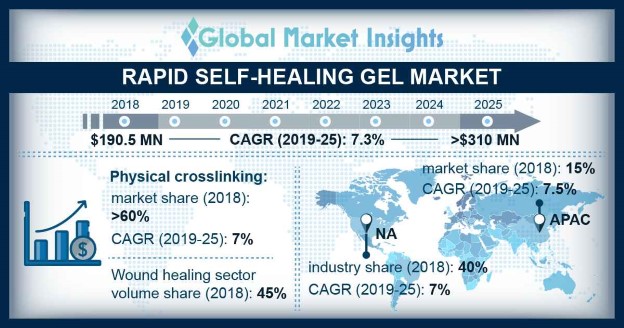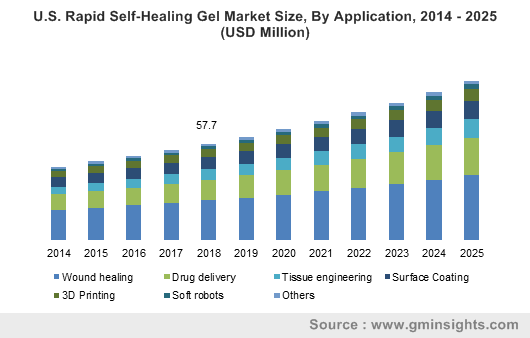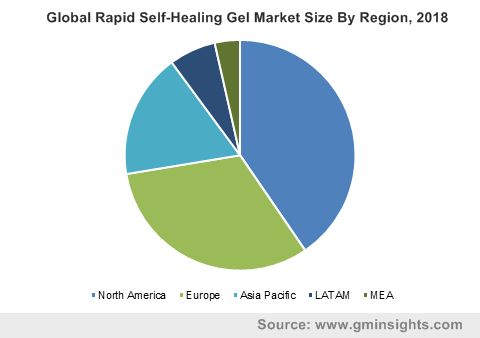Home > Chemicals & Materials > Advanced Materials > Functional Materials > Rapid Self-healing Gel Market
Rapid Self-healing Gel Market Size By Crosslinking (Physical, Chemical), By Applications (Wound Healing, Drug Delivery, Tissue Engineering, Surface Coating, 3D Printing, Soft Robots), Industry Analysis Report, Regional Outlook, Growth Potential, Price Trends, Competitive Market Share & Forecast, 2019 – 2025
- Report ID: GMI3271
- Published Date: Apr 2019
- Report Format: PDF
Rapid Self-healing Gel Market Size
Rapid Self-healing Gel Market size was over $190 million in 2018 and will witness a CAGR more than 7% between 2019 and 2025. Strong growth in the tissue engineering field which involves biomaterial science, cell biology, cell material interactions and surface characterization is likely to play a key role in the market growth in the coming years.

For instance, tissue engineering & regenerative medicine business in 2013 was valued close to USD 17 billion, which rose to $47.2 billion by the end of 2018, mainly due to consistent innovation and development carried out in the biomedical field and rising need to improve patient experience. Rapid self-healing gels, also known as hydrogel, are 3D water swollen structures which are primarily composed of copolymers.
| Report Attribute | Details |
|---|---|
| Base Year: | 2018 |
| Rapid Self-healing Gel Market Size in 2018: | 190 Million (USD) |
| Forecast Period: | 2019 to 2025 |
| Forecast Period 2019 to 2025 CAGR: | 7% |
| 2025 Value Projection: | 310 Million (USD) |
| Historical Data for: | 2014 to 2018 |
| No. of Pages: | 105 |
| Tables, Charts & Figures: | 177 |
| Segments covered: | Crosslinking, Applications and Region |
| Growth Drivers: |
|
| Pitfalls & Challenges: |
|
Insolubility of these structures is mainly due to its physical or chemical crosslink which also provides its shapes. In tissue engineering, the product is applicable as polymer scaffolds, implanting or injecting to deliver cell or gene into the body.
Growing prevalence of diabetes and burn incidences are triggering the demand for wound dressing products in the U.S. According to Centers for Disease Control and Prevention (CDC), as of 2015, 30.3 million Americans had diabetes and more than 84 million had prediabetes, a condition that if not treated, often leads to type 2 diabetes. Diabetes further hampers the normal physiological functions in the body, which leads to delayed wound healing and development of diabetic foot ulcers. The trends are likely to have a subsequent positive impact on the rapid self-healing gel market share in the forecast timeframe.
Volatile raw material prices are expected to hamper the market growth in the coming years. The base monomer of hydrogel or rapid self-healing gel are the petroleum derivatives and any fluctuation in polypropylene prices will have consequent impact on the prices of polymers which are used in the preparation of rapid-self healing gel. However, consistent advancement in the biomedical field has led to strong rise in demand for biomaterials with excellent healing properties, which will generate ample opportunities for the rapid self-healing gel market trends in forecast time period.
Rapid Self-healing Gel Market Analysis
Rapid self-healing gel market for physical crosslinking segment constituted more than 60% of the total industry share in 2018 and is anticipated to witness gains close to 7% in the forecast timeframe. In physical crosslinking, rapid self-healing gels are highly stable in the presence of 3D network, in which the polymer chains are linked by stable covalent bonds.
Some of the examples of physical crosslinking-based product are xanthan–glucomannan, PEG-polyester copolymers or poly(N-isopropylacrylamide) (pNIPAAm), among several others. These gels exhibit excellent mechanical, self-healing and ionic conductive properties.

In terms of volume, wound healing segment constituted approximately 45% of the total industry share in 2018. The gels are widely applicable in wound dressing or healing owing to its excellent properties which includes high sensitivity to physiological environments, hydrophilic nature, soft tissue-like water content and adequate flexibility, which makes them excellent entrants for biomedical applications.
For instance, the global population base pertaining to the age group 60 years was 841 million in 2014 and is projected to reach 2 billion in 2050. The people in this age group are expected to experience a growth in the occurrence of chronic wounds such as venous stasis ulcers and pressure ulcers, which will have significant positive impact on the product demand, thereby driving the rapid self-healing gel market growth in the forecast timeframe.
In 2018, Asia Pacific constituted approximately 15% of the total industry size and is likely to rise at CAGR close to 7.5% in the forecast period. High investment in R&D and demand surge for specialty medical products in the pharmaceutical & healthcare industry will have a notable impact on the product demand and thus trigger the rapid self-healing gel market in the region in the foreseeable future.
Furthermore, rapidly growing population and unavailability of efficient pharmaceutical facilities in the region will drive the market growth by 2025.
Rapid Self-healing Gel Market Share
Rapid self-healing gel market is consolidated with key players capturing the major chunk of the total market size in 2018. Some of the prominent players are:
- Scapa Healthcare
- Cardinal Health
- Katecho, Inc
- Axelgaard
- Alliqua Biomedical
- Contura
- Advanced Medical Solutions Group PLC
- Hydromer, Inc.
Some of the players in the rapid self-healing gel industry are forming strategic alliances with small or medium scale players to develop innovative medical products and gain an edge over their competitors. For instance, Alliqua Biomedical announced a joint venture with Adynxx, Inc. in October 2018, to focus on developing new products for treatment of pain. This move was intended to incorporate new technology for producing novel treatment methods.
Industry Background
Rapid self-healing gel are 3D materials having the ability to absorb large amounts of water, while maintaining their dimensional stability. Their three-dimensional framework in their swollen state is maintained by physical or chemical crosslinking. Additionally, the product possesses soft tissue-like physical properties, low interfacial tension, higher permeability to small molecules, and release of entrapped molecules in a controlled manner. These properties made hydrogels viable to be explored in different biomedical fields including tissue engineering, surface coating, drug delivery, wound healing, soft robots, etc.
Substantial investment in medical & healthcare R&D by the major players and unavailability of efficient healthcare facilities mainly in the emerging economies are likely to boost product demand, which will help augment rapid self-healing gel market growth in the forecast timeframe.
Rapid self-healing gel market report includes in-depth coverage of the industry, with estimates & forecast in terms of volume in tons and revenue in USD million from 2014 to 2025, for the following segments:
Click here to Buy Section of this Report
By Crosslinking
- Physical
- Chemical
By Application
- Wound healing
- Drug delivery
- Tissue engineering
- Surface Coating
- 3D Printing
- Soft robots
- Others
The above information is provided on a regional and country basis for the following:
By Region
- North America
- U.S.
- Canada
- Europe
- Germany
- UK
- France
- Spain
- Italy
- Asia Pacific
- China
- India
- Japan
- Australia
- Indonesia
- Malaysia
- Latin America
- Brazil
- Mexico
- Middle East & Africa
- South Africa
- Saudi Arabia
- UAE
- Kuwait

